We Are Social Asia Tuesday TuneUp #18
How Dove used Sina Weibo for its social media campaign
For last year’s Chinese Valentine’s Day on August 6, Dove promoted its chocolate gift set in China through a social media campaign on Sina Weibo. To bring to life the idea of leveraging on Dove’s heart-shaped gift box as a way to express love, Dove brought in Ma Jin, an industrial artist, who wished to build a carriage decorated with Dove’s heart-shaped tin boxes, and which he managed to do through donations of these tin boxes by users on Weibo. The campaign generated 47,683 retweets, 34,328 comments, 850,000 click through social network traffic to Ma Jin’s Weibo page, 3.3 million unique impressions on major social networks, and a 226% increase in Dove’s chocolate gift set sales during the Chinese Valentine’s Day period last year. This activity even resulted in a search trend for “carriage boy.”
Search becomes social in China
China has begun making search engines more social as Baidu, the country’s largest online search player, announced that it has begun indexing real-time results from popular microblogging service Sina Weibo. Baidu now prominently displays real-time news and trending content from Sina Weibo in its search results, and also includes related content from three other microblog services including Tencent Weibo. Results from microblogs are shown at the top of the results page, and are indicated as results that have been taken from these social sites. Zhang Dongcheng, an executive assistant at Baidu, believes this change will bring more relevant search results to users.
We process billions of search queries on a daily basis, and many of those queries are related to the real-time information found on microblog posts. With this deal between Baidu and Sina Weibo, Baidu has completed its integration of high-quality content from China’s four leading microblog platforms.
Instagram adds support for Asian social networks, hits 25 Million Users
Instagram has updated its popular photo-sharing app, which now supports Chinese microblogging service Sina Weibo and Japanese social network Mixi. Instagram has also hit the 25 Million user mark, with 10 million fans joining the network since Christmas. Unfortunately, it’s still yet to be available on Android.
Japanese mobile calling and messaging app hits 20 million downloads
Korean Internet firm Naver’s mobile calling and messaging application Line, which was designed and developed in Japan, has hit the milestone of 20 million downloads worldwide 8 months after its launch, of which 12 million downloads were made outside of Japan. Line sees one million new downloads worldwide each week, and has achieved 5 million downloads in February alone. In addition to sending instant messages , group chats and sharing emoticons, which are functionalities provided by Whatsapp, Line allows voice calls to be made as well. Naver is currently developing PC, Mac and tablet versions of its mobile app, which may see it competing against the likes of Skype, and hopes to reach 100 million by the end of this year.
Top brands on social media in India
According to the findings of NM Incite’s Social Media Brand Equity Ranking (SMBER) index, Samsung mobile is the most popular brand on social media platforms in India in terms of consumers’ top-of-mind on platforms such as Twitter, Facebook and other online sites. Ford India came in second, and enjoys high positive sentiments compared to other auto brands, and also receives positive response from consumers on social media in terms of its after-sale services. Maruti Suzuki, a subsidiary company of Japanese automaker Suzuki Motor Corporation, ranks third, while Nike and Flipkart, an e-commerce company, rank fourth and fifth respectively. The SMBER index covers social media buzz of 400 brands in India from the period of 1st January to 31st December 2011.
Mobile payment through Visa-certified NFC-enabled smartphones
Many have touted mobile payments as a trend that will take off in the near future, but without support from hardware manufacturers it’s unlikely to gain much traction. We may get to see this happen soon as Visa has certified the Samsung Galaxy S II, LG Optimus NET NFC, BlackBerry Bold 9900, BlackBerry Bold 9790, BlackBerry Curve 9360 and BlackBerry Curve 9380 to utilise its new Visa payWave technology. This will definitely help to encourage the adoption of NFC payments and services through mobile devices. By approving the NFC controller that mobile vendors are using in their devices, Visa ensures that a customer’s details are securely authenticated using the secure element on the device without being compromised. We’ll have to wait and see which banks or financial institutions will step up to the plate to offer an application for these Visa-certified NFC-enabled smartphones.
The decline of the media industry
Since we’re in social media, it seems pretty app to talk about this infographic featured on The Next Web that illustrates the decline of traditional media, even as social media is increasingly incorporated as a large part of brands’ marketing and communication tools. Even though traditional forms of media such as print publications and TV are not going to disappear anytime soon, it is still important to note that 41% of people who read a newspaper do so online, compared to 31% who read print newspapers. This signals a shift in where more of your brand’s marketing dollars should go to even as they continue being split amongst several different media.
Social media to take 19.5% of marketing budgets
February’s findings from the CMO survey reveal that social media spending as a percentage of marketing budgets is set to increase from 7.4% to 10.8% over the next 12 months, with a predicted increase up to 19.5% over the next 5 years:
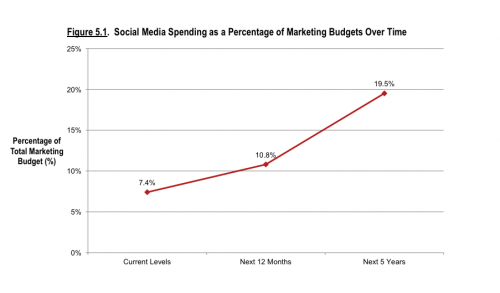
Are brands ignoring Facebook’s interactive potential?
Consulting firm A.T Kearney analysed conversations that took place on Facebook between 50 top brands and their fans. Findings saw that in 2010, 91% of the top 50 brands’ Facebook pages directed users to a one way communication page, and this figure increased in 2011 to 94%.
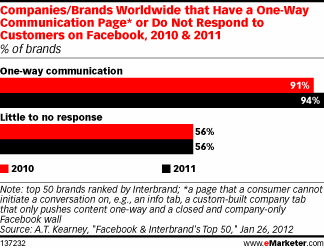
Additionally, 56% of those brands did not respond to a single customer comment on their Facebook page in 2011; the same percentage of non-responses as in 2010. In other words, a woefully large proportion of brands aren’t interacting as much as they could or should…
Privacy Management on Social Networks
The Pew Research Centre have found that social networking users are becoming more savvy and in control of actively managing their privacy, with 58% of users restricting access to their profiles. The findings, compared to data from 2009, reveal a 7% increase on both the deletion of friends and comments, and found that 37% of users actively remove their names from photos they are tagged in.
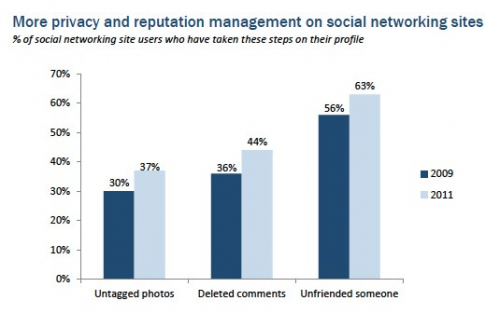
Television, commercials and Facebook engagement
Buddy Media has analysed a sample of 44 Super Bowl commercials and 34 associated Facebook Pages. Brands who integrated social media into their Super Bowl ads had the highest level of increased engagement, with a 61% higher growth rate than brands who chose not to reference their presence on Facebook.
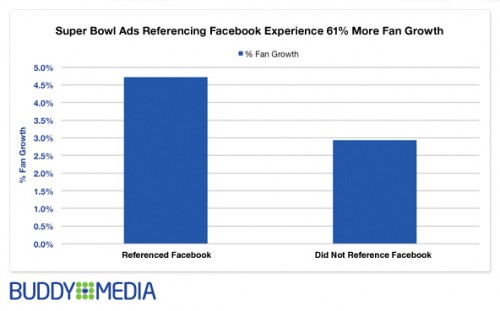
Interestingly, fan growth for brands featuring celebrities in their ads was 2.6x higher than average:
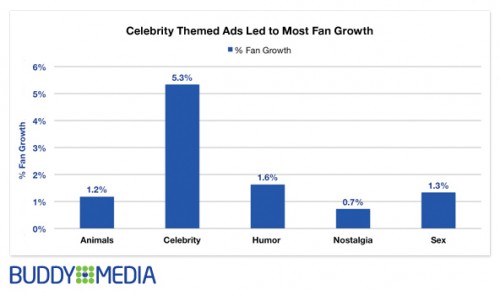
Brands who interacted on Facebook about the Super Bowl during time of play, saw a 60% increase in their engagement levels. Similar findings occured with The Oscars, where updates sent shortly before or after the Academy Awards saw an increase in levels of interactions – 2 times higher than posts mentioning The Oscars at other times.
Facebook’s major updates last week
If you haven’t heard, last week Facebook released timeline for pages and a slew of other major changes. Robin has outlined the top ten changes you need to know about, and we’ve also shared our experience of creating a Facebook timeline for a brand. We highly recommend you have a read.
In other updates, Facebook questions now appear in users mobile newsfeeds and Product Manager Jeff Kanter has revealed that upcoming changes will allow page owners to assign different levels of privileges to admins. Kanter explained that pages will offer five levels of admin access, including ‘full access’, ‘publishing-only access’, and ‘insights access’.
Facebook’s Disaster Message Board
Facebook have been testing a feature in Japan called ‘The Disaster Message Board’. It allows users to notify others they or their friends are safe during or after a disaster, by clicking the ‘mark safe’ button. A ‘safe’ tag will be added to the users profile, letting friends and family know they are in no harm. Facebook have said the new feature, still in testing, will not be a permanent placement, but instead become visible when disasters or emergencies occur.
Promoted Tweets are now on mobile
Twitters most recent changes allow for mobile users to see Promoted Products as they do on Twitter.com, with promoted Tweets appearing in their timeline and promoted accounts listed in ‘Who to Follow’.
As user spend less time on Google+ the network rolls out new features
Comscore have revealed that, despite Google+ hitting 90million users last month, people are spending less and less time on the site. Down from 4.8 minutes in December and 5.1 minutes in November, American users have averaged a significantly lower 3.3 minutes on the site in January. Google+ continue to add new features – this week to hang outs, adding a range of ‘diverse’ special effects aimed at encouraging more users to use video chat.
20 Million Gaga Followers
Not content with breaking records in the charts, Lady Gaga has become the first Twitter user to break the 20million followers mark. Racing ahead of the competition (Katy Perry is stuck on 15.7 million whilst Britney Spears is lagging behind with just 13.5 million), Gaga’s main threat is Justin Bieber – with 18 million followers. Gaga claims all Tweets are her own, which possibly heightens her appeal – take note Miss Spears.
Tesco Virtual Fitting Room
The big news this week, was our campaign for Tesco to promote their new virtual 3D fitting room. Emily Shamma, director of Tesco online clothing, said:
We Are Social has really got under the skin of how women discuss fashion online, and built a campaign that will encourage them to try out this new technology by integrating it into their existing social behaviour.
Pampers live webstream TV on Facebook
Pampers UK & Ireland brought their live ‘Sleep WebTV Show’ to their 90,000 Facebook fans, in what could be a Facebook first. The live show ran a question and answers session with specialist Wendy Dean, who instantly answered fans submitted queries on encouraging a baby’s good nights sleep.
Domino’s Pizza ‘Tweet for Treats’
Aiming to boost lunchtime trade, today saw Domino Pizza encouraging fans to Tweet them with the hash-tag #Letsdolunch. The incentive? Each Tweet received between 9am-11am saw 0.01p knocked off a Pepperoni Pizza, which consumers could then buy between midday and 3pm.
KFC’s Facebook party
KFC Australia’s Facebook competition “Goodest Gets Together” gave it’s fans the opportunity to party – with 100 of the winners’ Facebook friends. The competition ran as part of the wider KFC ‘Goodification’ campaign, where fans respond with equally grammatically incorrect responses, including ‘gooder’, ‘gooderer’ and ‘goodest’ – all of which could work in KFC’s favour if they become synonymous with the brand. Winner Liz Daly hosted a party funded by the fast food chain, who flew friends from all around the world to her special event.
Coca-Cola Australia losses community spirit
A social experiment left its followers bubbling up with insults, as Coca-Cola Australia invited its Facebook fans to “Add a word to the person above you to create a happy story!” With more than 700 responses, the fans engaged with a flurry of insults and obscenities, often about each other. Coca-Cola responded by deleting comments they deemed ‘inappropriate’.
Brad Keselowski gains 100,000 followers in less than 2 hours
Want to gain 100,000 Twitter followers in less than two hours? Nascar Driver Brad Keselowski did so after fellow driver, Juan Pablo Montoya, crashed into a safety vehicle mid-race at Daytona 500. The collision caused a fire ball and the race was halted, giving Keselowski the perfect opportunity to share a Twitpic of the event, to his 85,000 followers. Two hours later, the driver had a following of 185,000, who he actively updated about the progress of the race. When the race resumed, it was Keselowski turn to take an unfortunate crash- but of course, he didn’t fail to keep his followers updated “Nothing we could do there…never saw the wreck till we were windshield deep. #DAYTONA500″
#RIPGreggJevin
Fuelled by comedian Michael Legge’s tweet “Sad to say that Gregg Jevin, a man I just made up, has died #RIPGreggJevin”, Twitter saw a wave of tributes, as other comedians and popular publications added their humorous contributions, pushing #RIPGreggJevin to the top of Twitter trends.
